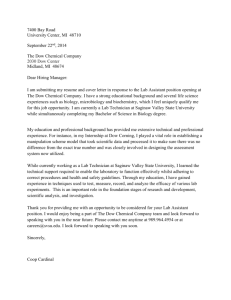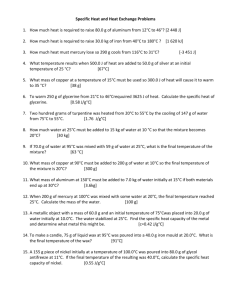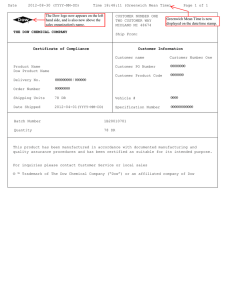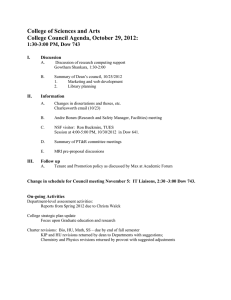Product Safety Assessment Glycerine
advertisement
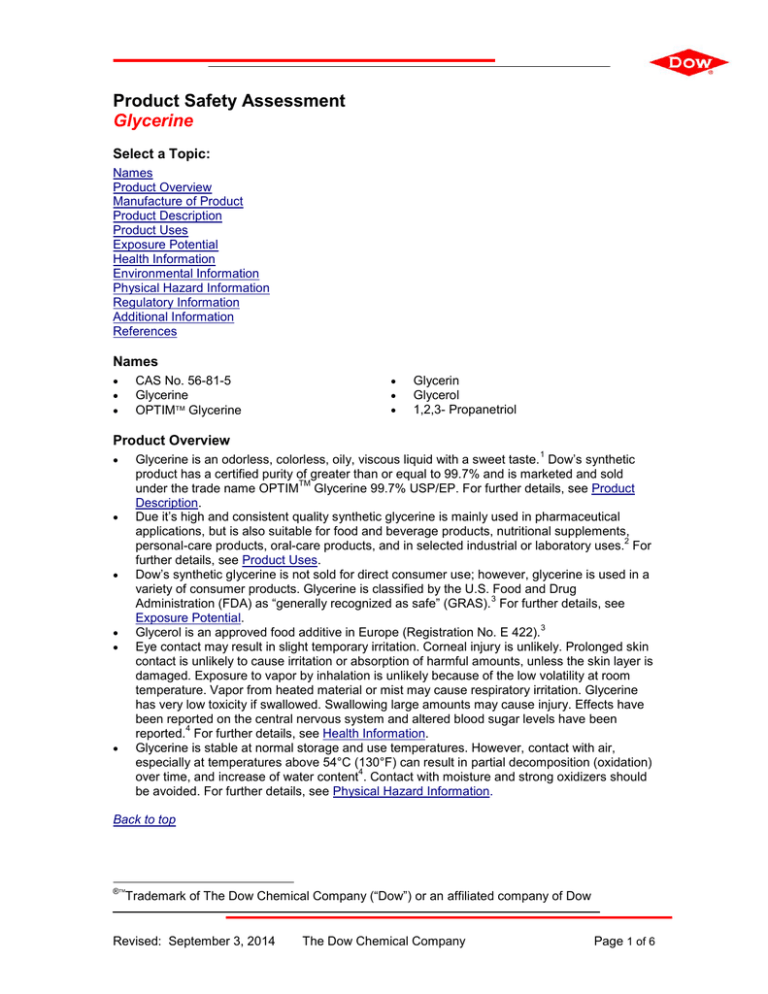
Product Safety Assessment Glycerine Select a Topic: Names Product Overview Manufacture of Product Product Description Product Uses Exposure Potential Health Information Environmental Information Physical Hazard Information Regulatory Information Additional Information References Names CAS No. 56-81-5 Glycerine OPTIM Glycerine Glycerin Glycerol 1,2,3- Propanetriol Product Overview 1 Glycerine is an odorless, colorless, oily, viscous liquid with a sweet taste. Dow’s synthetic product has a certified purity of greater than or equal to 99.7% and is marketed and sold TM under the trade name OPTIM Glycerine 99.7% USP/EP. For further details, see Product Description. Due it’s high and consistent quality synthetic glycerine is mainly used in pharmaceutical applications, but is also suitable for food and beverage products, nutritional supplements, 2 personal-care products, oral-care products, and in selected industrial or laboratory uses. For further details, see Product Uses. Dow’s synthetic glycerine is not sold for direct consumer use; however, glycerine is used in a variety of consumer products. Glycerine is classified by the U.S. Food and Drug 3 Administration (FDA) as “generally recognized as safe” (GRAS). For further details, see Exposure Potential. 3 Glycerol is an approved food additive in Europe (Registration No. E 422). Eye contact may result in slight temporary irritation. Corneal injury is unlikely. Prolonged skin contact is unlikely to cause irritation or absorption of harmful amounts, unless the skin layer is damaged. Exposure to vapor by inhalation is unlikely because of the low volatility at room temperature. Vapor from heated material or mist may cause respiratory irritation. Glycerine has very low toxicity if swallowed. Swallowing large amounts may cause injury. Effects have been reported on the central nervous system and altered blood sugar levels have been 4 reported. For further details, see Health Information. Glycerine is stable at normal storage and use temperatures. However, contact with air, especially at temperatures above 54°C (130°F) can result in partial decomposition (oxidation) 4 over time, and increase of water content . Contact with moisture and strong oxidizers should be avoided. For further details, see Physical Hazard Information. Back to top ® Trademark of The Dow Chemical Company (“Dow”) or an affiliated company of Dow Revised: September 3, 2014 The Dow Chemical Company Page 1 of 6 Product Safety Assessment: Glycerine Manufacture of Product Capacity – World consumption of natural and synthetic glycerine combined was 5 approximately 1.86 Mt million metric tons (4.1 billion pounds) in 2011. Dow produces synthetic glycerine at a dedicated production facility in Stade, Germany. Process – Although glycerine can be derived from naturally occurring fats and oils, synthetic 1 glycerine from Dow is produced from petrochemical products in a multi-step process. Current Good Manufacturing Practices (cGMP) based on the Joint IPEC-PQG Good 6 Manufacturing Practices Guide for Pharmaceutical Excipients are applied to the manufacturing process. The structure of glycerine is shown below: OH HO CH2CHCH2 OH Back to top Product Description1,3 Glycerine is an odorless, colorless, oily, viscous liquid with a sweet taste. Dow’s synthetic product is typically equal to or greater than 99.7% pure. It is marketed and sold under the trade name OPTIM Glycerine. OPTIM Glycerine is in compliance with the relevant standards set by the current United States Pharmacopeia (USP) and European Pharmacopoeia (Ph. Eur. or EP).. Additionally, it is Kosher and Halal certified. Back to top Product Uses2,5 Synthetic glycerine is primarily used in: Pharmaceutical products – as a sweetener, humectantin syrups and lozenges, and as an ingredient in eyewashes, ear drops, jellies and creams, solutions, suppositories, and gel capsules OPTIM Glycerine may also be used in other applications which require high purity, consistency and stability such as Food and beverage products – as an additive to reduce water activity, emulsifiers for monoglycerides, heat-transfer media for frozen foods, humectants, smoothing agents, solvents for flavorings and colorings, and sweeteners. Nutritional supplements Personal-care products – as a humectant, lubricant, emollient, and suspension aid in lotions, creams, soaps, pastes, and hair-care products Oral-care products Polyurethane products Other – for selected other agricultural, industrial, and laboratory uses ® Trademark of The Dow Chemical Company (“Dow”) or an affiliated company of Dow Revised: September 3, 2014 The Dow Chemical Company Page 2 of 6 Product Safety Assessment: Glycerine World Consumption5 Back to top Exposure Potential4 Glycerine is used in the production of industrial and consumer products. Based on the uses for glycerine, the public could be exposed through: Workplace exposure – Exposure can occur either in a glycerine manufacturing facility or in the various industrial or manufacturing facilities that use glycerine. Those working with glycerine in manufacturing operations could be exposed during maintenance, sampling, testing, or other procedures. Each manufacturing facility should have a thorough training program for employees and appropriate work processes and safety equipment in place to limit unnecessary exposure. See Health Information. Consumer exposure to products containing glycerine – Dow’s glycerine is not sold for direct consumer use, but it is used in a variety of consumer products. See Health Information. Environmental releases – In the event of a spill, the focus is on containing the spill to prevent contamination of soil and surface or ground water. For small spills, glycerine should be absorbed with materials such as sand, sawdust, or soil. Sweep up and collect recovered material in suitable and properly labeled containers. See Environmental, Health, and Physical Hazard Information. Large release – Industrial spills or releases are infrequent and generally contained. If a large spill does occur, dike the area to contain the spill. The material should be captured, collected, and reprocessed or disposed of according to applicable governmental requirements. In case of fire – Isolate the area and deny unnecessary entry. Firefighters should wear positive-pressure, self-contained breathing apparatus (SCBA) and protective clothing or fight the fire from a protected location or distance. Use water fog or fine spray, carbon-dioxide or dry-chemical extinguishers, or foam to fight the fire. Alcohol-resistant foams are preferred. Use of a direct water stream may spread fire. Follow emergency procedures carefully. See Environmental, Health, and Physical Hazard Information. For more information, request the relevant Safety Data Sheet from the Dow Customer Information Group. Back to top Revised: September 3, 2014 The Dow Chemical Company Page 3 of 6 Product Safety Assessment: Glycerine Health Information4,7 Glycerine is classified by the U.S. Food and Drug Administration (FDA) as “generally recognized as safe” (GRAS) and complies with specifications for the Food Chemicals Codex (FCC), United States Pharmacopeia (USP), and European Pharmacopoeia (Ph. Eur. or EP) E244. It is manufactured according to current Good Manufacturing Practices (cGMP) and is shipped according to applicable Good Trade and Distribution Practices (GTDP). Eye and skin contact – Eye contact may result in slight temporary irritation. Corneal injury is unlikely. Prolonged skin contact is unlikely to cause irritation or adsorption of harmful amounts, unless the skin layer is damaged. Inhalation – Inhalation exposure is unlikely because of the low volatility at room temperature. Vapor from heated material or mist may cause respiratory irritation. Ingestion – Glycerine has very low toxicity if swallowed. Small amounts swallowed incidental to normal handling operations are unlikely to cause injury. Swallowing large amounts may cause injury. Effects have been reported on the central nervous system and altered blood sugar levels have been observed. Other – Excessive, repeated exposure to glycerine may cause increased fat levels in the blood. Glycerine has not caused cancer in laboratory testing, nor did it cause birth defects or other fetal effects. Some reproductive effects have been observed in female animals due to the altered nutritional states resulting from extremely high doses in the diet. Genetic toxicity studies have been negative. For more information, request the relevant Safety Data Sheet from the Dow Customer Information Group. Environmental Information4,7 The potential for glycerine to bioconcentrate (accumulate in the food chain) is low, and the potential for mobility in soil is very high. Glycerine is classified as readily biodegradable and is considered practically non-toxic to aquatic organisms on an acute basis. For more information, request the relevant Safety Data Sheet from the Dow Customer Information Group. Back to top Physical Hazard Information4,7 Glycerine is stable at normal storage and use temperatures. However, temperatures above 54°C (130°F) can result in decomposition. Decomposition products can include, but are not limited to, acrolein. Avoid contact with moisture and strong oxidizers. For more information, request the relevant Safety Data Sheet from the Dow Customer Information Group. Back to top Regulatory Information Regulations may exist that govern the manufacture, sale, transportation, use, and/or disposal of glycerine. These regulations may vary by city, state, country, or geographic region. Information may be found by consulting the relevant Safety Data Sheet or by Contact Us. Back to top Revised: September 3, 2014 The Dow Chemical Company Page 4 of 6 Product Safety Assessment: Glycerine Additional Information Glycerol IUCLID file on ECHA dissemination webpage: http://apps.echa.europa.eu/registered/data/dossiers/DISS-9d855cc7-316c-2a21-e04400144f67d249/DISS-9d855cc7-316c-2a21-e044-00144f67d249_DISS-9d855cc7-316c-2a21e044-00144f67d249.html Safety Data Sheet (request from Dow Customer Information Group at http://www.dow.com/assistance/dowcig.htm) Contact Us (http://www.dow.com/optim/contact/) Synthetic Glycerine Products: Safety and Handling, The Dow Chemical Company, Form No. 115-00650-1199X SMG Synthetic Glycerine Products: General Storage Considerations, The Dow Chemical Company, Form No. 115-00651-1199X SMG Synthetic Glycerine Products: Product Stewardship, The Dow Chemical Company, Form No. 115-00652-1199X SMG Why Glycerin USP?, The Soap and Detergent Association, 2000 The Joint IPEC / PQG Good Manufacturing Practices Guide for Bulk Pharmaceutical Excipients, The International Pharmaceutical Excipients Council (IPEC) and Pharmaceutical Quality Group, 2006 IPEC Guidelines For more business information about OPTIM Glycerine visit Dow’s Glycerine site: http://www.dow.com/optim/ Back to top References 1 Why Glycerin USP?, The Soap and Detergent Association, 2000 Glycerine applications website, The Dow Chemical Company (“Dow”): http://www.dow.com/optim/optim-advantage/applications.htm. 3 Glycerine products website, Dow: http://www.dow.com/optim/ 4 OPTIM Glycerine 99.7% USP/EP, Material Safety Data Sheet, The Dow Chemical Company, 5 Dow Chemical internal data, Glycerine market study 2011 6 The Joint IPEC / PQG Good Manufacturing Practices Guide for Bulk Pharmaceutical Excipients, The International Pharmaceutical Excipients Council (IPEC) and Pharmaceutical Quality Group, 2006. IPEC Guidelines 7 Synthetic Glycerine Products: Safety and Handling, The Dow Chemical Company, Form No. 115-00650-1199X SMG 2 ® Trademark of The Dow Chemical Company (“Dow”) or an affiliated company of Dow Revised: September 3, 2014 The Dow Chemical Company Page 5 of 6 Back to top NOTICES: As part of its 2015 Sustainability Goals, Dow has committed to make publicly available safety assessments for its products globally. This product safety assessment is intended to give general information about the chemical (or categories of chemicals) addressed. It is not intended to provide an in-depth discussion of health and safety information. Additional information is available through the relevant Safety Data Sheet, which should be consulted before use of the chemical. This product safety assessment does not replace required communication documents such as the Safety Data Sheet. The information herein is supplied upon the condition that the persons receiving same will make their own determination as to its suitability for their purposes prior to use. In no event will Dow be responsible for damages of any nature whatsoever resulting from the use of or reliance upon the information herein or the product to which that information refers. Nothing contained herein is to be construed as a recommendation to use any product, process, equipment or formulation in conflict with any patent, and Dow makes no representation or warranty, express or implied, that the use thereof will not infringe any patent. NO REPRESENTATIONS OR WARRANTIES, EITHER EXPRESS OR IMPLIED, OF MERCHANTABILITY, FITNESS FOR A PARTICULAR PURPOSE OR OF ANY OTHER NATURE ARE MADE HEREUNDER WITH RESPECT TO INFORMATION OR THE PRODUCT TO WHICH INFORMATION REFERS. Dow makes no commitment to update or correct any information that appears on the Internet or on its World-Wide Web server. The information contained in this document is supplemental to the Internet Disclaimer, http://www.dow.com/homepage/term.htm. Back to top Form No. 233-00490-MM-0914X Revised: September 3, 2014 The Dow Chemical Company Page 6 of 6
